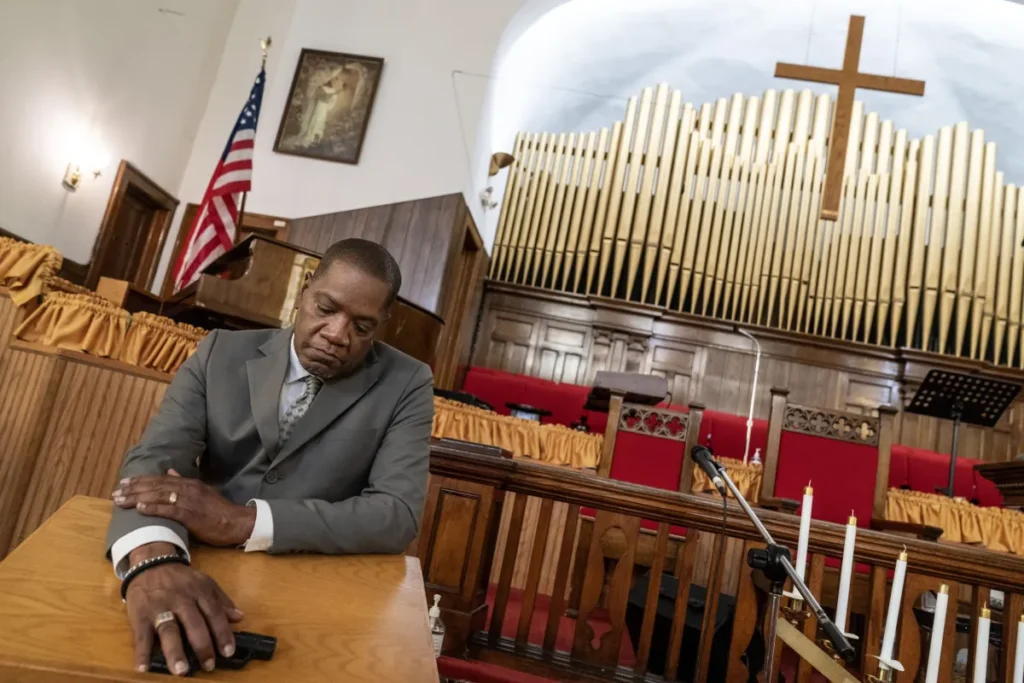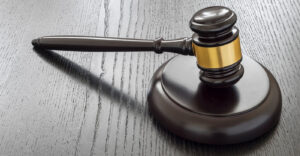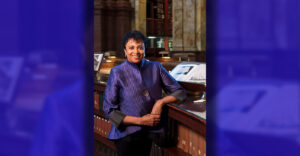Two pastors worry for their congregants’ safety. Are more guns the answer or the problem?

by ADAM GELLER AP National Writer
Inside the columned church on the corner, the rich tones of the organ have wrapped congregants in their embrace. The time has come for the Rev. Jimmie Hardaway Jr. to preach the lessons embodied by the Prince of Peace.
If only the world outside Trinity Baptist’s stained-glass windows were a more peaceful one. Alas, it is not.
So when Hardaway rises to the pulpit this Sunday morning – weeks after a 24-year-old man was shot to death in the street two blocks from the chapel, and days after a mass shooting claimed six lives at a church-run school in Tennessee – he carries a .380 caliber semiautomatic pistol concealed in the pinstriped folds of his suit.
“I’m really not free if I have to sit here and worry about threats to a congregation,” says Hardaway, one of several religious leaders who sued New York officials last fall after lawmakers restricted guns in houses of worship. He notes the similarities between Trinity’s worshippers and those at a historic Black church in Charleston S.C., where a mass shooter killed nine people in 2015.
“I’m really not free if I know that there’s someone who can do harm and I can’t do anything to protect them,” says Hardaway, whose city struggles with one of the state’s highest rates of violent crime.
The decision Hardaway has made is a distinctly American one. And it spotlights rising friction between the assertion of two very American principles: the right to worship and the right to own guns. With U.S. deaths by gunfire reaching record levels, it is far from an isolated instance of that tension.
At the same hour, about 90 miles away, the Rev. Stephen Cady and his flock at Asbury First United Methodist Church in Rochester, N.Y., are also seeking sanctuary.
And in a country where many faith leaders say their jobs now require them to draw up plans for responding to a mass shooter on their premises, Cady has reached the diametrically opposite conclusion.
His church, in a city where 63 people were killed in shootings last year, presides over a leafy neighborhood of carefully kept homes largely bypassed by the violence. But for a congregation unsettled by the increase in mass shootings and the deaths across town that garner far less attention, the way forward would only be darkened by adding even more guns, Cady says.
“Let us pause for a moment together … just outside the violence of the week ahead, that we might at least acknowledge the violence of the week we have just left behind,” preaches Cady, a father of three. He tells his worshippers of the dread he felt learning that one of those slain in the Tennessee mass shooting was the 9-year-old daughter of that church’s pastor.
“Here we stand … outside of the gate, longing for nothing more than to get to that new life on the other side,” he says. “Yet hell seems to have found us.”
Two men, brothers in Christ but unknown to one another, each determined to exercise their American right to pray without interference.
To one, the right to bear arms – and the proliferation of 400 million guns and thousands of shootings it has enabled – undermines the freedom to worship in peace. To the other, the right to carry a gun is an essential means of protecting fragile religious liberty.
At the core of American identity is the belief that everyone is endowed with certain rights – to voice their opinions freely, to gather with whoever they choose, to pursue life, liberty and happiness as they see fit.
But as the Supreme Court has adopted an increasingly expansive interpretation of the Second Amendment, the right to guns is casting a shadow over many other freedoms Americans hold dear.
That tension is becoming visceral in some houses of worship because, more and more, they feel like targets.
That was the case in 2012, when a gunman espousing white supremacist views killed six worshippers at the Sikh Temple of Wisconsin, in the town of Oak Creek. And in 2017, when a shooter entered the First Baptist Church in Sutherland Springs, Texas, slaying 25 people, including a pregnant woman. And a year later, when 11 people, including several who had survived the Holocaust, were killed by a gunman who invaded the Tree of Life synagogue in Pittsburgh.
The attacks, and more routine violence, weigh on places of worship that strive to offer refuge from the profanity of everyday life, says David Yamane, a professor of sociology at Wake Forest University whose work has focused on both gun culture and religion. It has left priests, rabbis and others to confront sometimes pained choices between maintaining openness and locking down, he says.
“Any kind of church shooting is a very low odds, but very high stakes event. But to be wrong would just be devastating,” Yamane says. “Almost every religious leader you talk to, no matter their background, that’s what they’re grappling with.”
In a survey of 1,000 Protestant pastors, conducted in 2019 by the Southern Baptist Convention’s research division, 62 percent said they had developed plans for responding to an active shooter. Nearly half said some in their congregations are now armed to provide security when they gather for prayer.
Ensuring safety in houses of worship most often centers on everyday concerns like medical emergencies and vetting those who care for children. But violent incidents at religious gathering places, tracked by the non-profit Faith Based Security Network, have increased more than twentyfold since 1999, with 60 percent of them involving guns.
Still, for leaders of some houses of worship, the threat can feel remote.
That is not the case at Hardaway’s church. In a neighborhood pocked by boarded-up homes, where votive candles and empty liquor bottles are arranged in street-corner memorials to young men killed during robberies and disputes, violence — much of it carried out with guns — is not abstract.
“This is not the answer!” the mother of 24-year-old Jaylan McWilson screamed during a sidewalk vigil Hardaway convened for her son, shot dead as he arrived home one evening in late January, within sight of Trinity Baptist. “God gave me a miracle son! And now he’s gone in the blink of an eye!”
Hardaway, 62, is the son of another mostly Black neighborhood in nearby Buffalo. Growing up there, he says, the pastor at his childhood church carried a gun for protection.
In 1989, Hardaway also began doing so, leading congregations in the Bronx, California and elsewhere, where neighborhood crime and all-hours calls to minister in sometimes tense family situations left him wary.
One time, when he wasn’t carrying a gun, “I had a guy beat his wife in my office and I couldn’t do anything. He was too big for me. All I could do was say: ‘Stop! Stop!’” he recalls.
In 2015, he was hired to replace the founding pastor at Trinity, about 2 miles (3 kilometers) from Niagara’s namesake falls. By then, he says, his worries about safety had faded, largely convincing him to leave his guns at home. Until one horrific night that June.
On that Wednesday evening, a young man walked into a Bible study session at Emanuel African Methodist Episcopal Church in Charleston, S.C. and killed nine people. The victims included the senior pastor, Clementa Pinckney. The shooter was an avowed white supremacist.
“It was like, OK, what if this happens to us?” says Hardaway, whose congregants, like Pinckney’s, are nearly all Black, many of them senior citizens. “It could be us.”






